Island-hopping in the Cyclades
The Cyclades. A group of islands in the Aegean Sea, so close to each other (island-hopping, anyone?) and yet so different. Like a group of old friends, each of them has her own distinct personality, her own unique character, her own charm.
Syros is the quiet leader, Mykonos her loud, party-loving, gay-friendly neighbor. With equal parts of hedonism and glamour, she is comfortably nestled between religious Tinos and chaste, pure Delos.
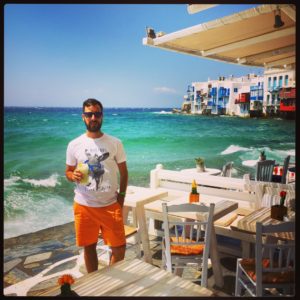
Santorini is the popular one, classic pageant material, the queen of Instagram (#Santorini: 6,122,817 posts). Then, there’s Folegandros. Stepping out of her sister’s shadow, she’s trendy and vibrant; some may call her hipster. Star-quality Amorgos is as enchanting as adventurous.
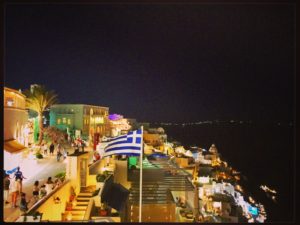
There’s something nostalgic, old-fashioned even, about Serifos. Like a yoga retreat, she may be calm and quiet, but never assume she’s boring. Take her to a yin yoga class (by the beach, of course) and she will surprise you by how effortlessly she can hold the asanas. Neighboring Sifnos is the Nigella of the group; you want to be in her backyard for a delicious, yet unpretentious, heart-warming meal. Followed by a few mojitos, of course.
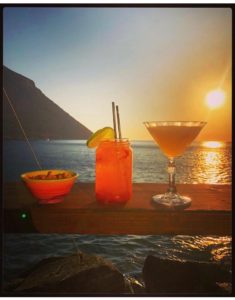
These are only some of the Cyclades, an archipelago of 24 inhabited islands (and many more uninhabited).

Even though I was born and raised in Greece, I had not visited the Cyclades until the summer of 2016. So impressed I was that I promised myself to come back every year, and try to visit a different island each time. It would’ve been easy to blame COVID-19 for not sticking to my promise, had I actually been to the Cyclades last year.
Island-hopping
I have previously suggested two island-hopping itineraries (check them out here and here), largely based on my own travel experiences. Today, however, I’m going to present these beautiful islands (in alphabetical order), both the ones I’ve already visited, and those that I will hopefully visit soon.
Amorgos
Inhabitants: 1,973
#Amorgos: 130,500 posts
If you asked me which my favorite Greek island is, I would struggle to come up with an answer. Yet, Amorgos would be among the first to spring to my mind. The easternmost of the Cyclades islands may not be as popular as its famous neighbor Santorini, but, cliché as it may sound, it is one of the most beautiful and charming Greek islands. In the last few years, Amorgos has been popular with the French, since it featured in Luc Besson’s film ‘Le Grand Bleu’ (‘The Big Blue’).
As well as its role in the French cult-classic, Amorgos is also renowned for its hiking trails. One of these trails, Fotodotis, connects Katapola (the main port) with Hora (the capital and one of the main settlements of the island). Hora is a charming inland village built on top of the Mount Profitis Ilias. Stroll through its narrow streets where blushing bougainvilleas climb the walls of white-washed houses and blue-domed churches and chapels; their doors and window shutters have been painted blue, red or green, matching the chairs and tables scattered around the cobblestone alleys.
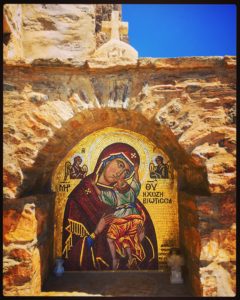
Then, walk past the windmills at the edge of Hora towards the landmark of Amorgos, the Greek-Orthodox monastery of Panagia Hozoviotissa. Built by Byzantine emperor Alexius Comnenus I in the 11th century, this whitewashed monastery is wedged into a cliff face 300 meters above the sea. From there, descend towards the pebble beach of Agia Anna. Here the waves splash against a rock, which a chapel of the same name is built on. It’s then time to dive into the deep blue Aegean.
For more tips, check out my post ‘Amorgos: Top 9 tips by an (almost) local‘.
Anafi
Inhabitants: 271
#Anafi: 47,195 posts
One of the smallest and least populated of the Cyclades, Anafi lies south of Amorgos and west of Santorini. Despite its close proximity to the latter (90 minutes by ferry), Anafi is relatively unknown and far less popular with tourists (and on Instagram). Yet, it is not any less insta-worthy.
Andros
Inhabitants: 9,221
#Andros: 187,605 posts
Andros is the northernmost and second-largest of the Cyclades. Nestled between the southern tip of Evia (Euboea) and Tinos, it used to be a major center of Greek shipping until the Second World War. The neo-classical mansions in the main town (also called Andros or Hora) are not only reminiscent of the island’s glorious past, but also of the Dodecanese islands. Like Amorgos, Andros is also renowned for its hiking trails.
Check out more tips for Andros here.
Antiparos
Inhabitants: 1,211
#Antiparos: 140,488 posts
Located west of Paros, Antiparos has been a popular holiday destination for the international jet-set, including Hollywood actor Tom Hanks, who owns a villa on the island.
Check out more tips for Antiparos here.
Delos
Inhabitants: 14
#Delos: 65,241 posts
The mythical birthplace of Apollo and Artemis, Delos is now a UNESCO World Heritage Site and one of the most important historical and archaeological sites in Greece. The least inhabited of all the inhabited Cyclades, Delos is home to only 14 people. Get there from Mykonos; the boat takes only half an hour; yet, it feels like thousand miles away from the buzz of cosmopolitan Mykonos.
Donousa
Inhabitants: 167
#Donousa: 10,219 posts
The Lesser (or Smaller) Cyclades comprise four inhabited islands (Donousa, Ano Koufonisi, Schinoussa and Iraklia) and a few more uninhabited ones. Donousa is located west of Naxos, whereas the other three are all located south of the largest of the Cyclades.
Folegandros
Inhabitants: 765
#Folegandros: 102,431 posts
Another one of the least known Greek islands, Folegandros is only an hour away (on the ferry) from the world-famous Santorini. This rather small Cycladic island is located in the southern Aegean Sea, nestled between Milos and Kimolos on the west, and Sikinos and Ios on the east (Santorini is further on the east).
Whitewashed houses, blushing bougainvilleas, cobbled alleyways. Welcome to Hora, the charming inland capital of Folegandros. Built on the edge of a 200-meter high cliff, Hora is where the heart of the island beats. Ditch your map (if you have one) and simply wander around the village taking in the friendly atmosphere. Color-coded tables and chairs from the inviting taverns in the squares of the village provide a picture-perfect backdrop. Then, stroll around Kastro, the oldest part of Hora, before you make your way to the church of Panagia.
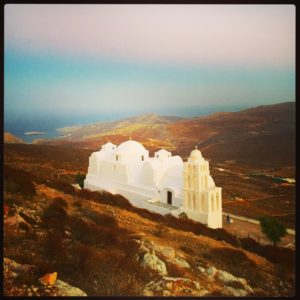
Dedicated to the Dormition of the Virgin Mary, this whitewashed church is the landmark of Folegandros. The ascending path is easy to climb (no more than 15 minutes from Hora), and it will reward you with panoramic views of the island. Evenings are the best time to visit, so you can watch the sunset.
For more tips, check out my post ‘Folegandros: the secret alternative to Santorini‘.
Ios
Inhabitants: 2,024
The island of Ios lies north of Santorini, south of Paros, and east of Sikinos. According to the legend, this is where Homer died. Nowadays, Ios is renowned as a party island, and is therefore a popular summer destination for the Greek youth. Centrally located in the Cyclades archipelago, this lively island can easily become part of your island-hopping itinerary.
Check out more tips for Ios here.
Iraklia
Inhabitants: 141
#Iraklia: 8,794 posts
#Irakleia: 3,686 posts
This tiny island is the largest of the Lesser Cyclades. Once the property of the monastery of Panagia Hozoviotissa on the nearby island of Amorgos, Iraklia (sometimes spelled Irakleia) is now home to about 140 people. There are two settlements on the island, Panagia (Virgin Mary) – the capital, and Agios Georgios (Saint George) – the port.
Kea (Tzia)
Inhabitants: 2,455
#Tzia: 31,610 posts
Of all the Cyclades, Kea (or Tzia) is the closest to Attica and Athens. Thanks to its close proximity to the Greek capital, Kea is an ideal weekend resort for the Athenians; for the rest of us, this beautiful island is a great summer destination. Commonly referred to as ‘the gate of the Cyclades’, Kea can easily be combined with island-hopping to other nearby islands, such as Kythnos or Syros.
Check out more tips for Kea here.
Kimolos
Inhabitants: 910
#Kimolos: 28,347 posts
Kimolos lies north of Milos and south of Sifnos, on the southwest of the Cyclades archipelago. This small round-shaped island may be less known and less popular compared to its neighbors, but it’s perfectly situated for island-hopping. From here, you can hop on the ferry to Milos, Sifnos, Folegandros, or Santorini.
According to kimolos-island.com, the tourist planning a vacation to Kimolos is a peace lover, a philosopher, an observer, fond of simple but tasty local cuisine, flying away from traffic and modernity.
Check out more tips for Kimolos here.
Koufonisi(a)
Inhabitants: 399
#Koufonisia: 71,252 posts
I have to admit that I had never heard of Koufonisia (‘Hollow Islands’) until a couple of years ago. Perhaps, this is because these three Cycladic islands are really really small. Actually, only one is inhabited: Ano (or Pano) Koufonisi (‘Upper Hollow Island’). Au contraire, Kato Koufonisi (‘Lower Hollow Island’) and Keros are not. Interestingly, when Greeks say ‘Koufonisia’, they usually refer to Ano Koufonisi, rather than all three. Despite their close proximity to Amorgos and Naxos, these tiny islands are considered remote and often described as ‘hidden gems’, ‘off the beaten track’ or ‘undiscovered paradise’, even for Greeks and Italians, who are the main visitors.
Hora is the island’s only village and spreads out behind the ferry quay. Wander along the main street towards the small harbor of Loutro, where you can have dinner at one of the seaside taverns.
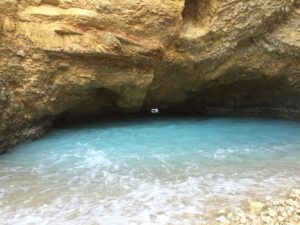
Or, go beach-hopping towards the beach of Pori. On your way there, you will pass by the small caves, one of the most famous sights of the island. Piscina (‘Pool’), or Devil’s Eye, is the one that attracts the biggest crowd – diving from the top of the cave into the naturally formed pool. Continue to Pori and then to the secluded by the caves ‘beach’ Gala. This is slightly tricky to find, as you can only see it once you are actually there. At Pori, hop on a boat taxi back to Hora. Alternatively, you can walk along the inland road.
For more tips, check out my post ‘Koufonisia: Top 9 tips by an (almost) local‘.
Kythnos
Inhabitants: 1,456
#Kythnos: 49,439 posts
Located between Kea and Serifos, Kythnos is one of the easiest islands to get to from Athens, and conveniently located for island-hopping. Over the last few years, it has become a very popular summer destination (among Greeks). Since there are no big holiday resorts here, accommodation may be challenging to find, unless booked well in advance. Once on the island, finding a beach won’t be as challenging; on the contrary, with more than 90 beaches in total, the fortunate visitor will have more than enough to choose from.
Check out more tips for Kythnos here.
Milos
Inhabitants: 4,977
#Milos: 416,878 posts
Two hundred years ago, in April 1820, a Greek peasant discovered an ancient statue, depicting Aphrodite, the Greek goddess of love and beauty. The marble statue, dating to the 2nd century BC, is on permanent display at the Louvre Museum in Paris. Nowadays, it is widely known as the Venus de Milo, to remind us of Milos, the Greek island where it was discovered.
Quite like Santorini, the southwesternmost of the Cyclades is a volcanic island with impressive landscapes as well as over 75 beaches. A perfect place to relax, but also conveniently located for island-hopping. In fact, Milos is one of the easiest islands to get to, either by ferry (from Piraeus, Crete, and other Cycladic islands) or by plane (there are daily flights from Athens, with the flight only taking 35 minutes).
Check out more tips for Milos here.
Mykonos
Inhabitants: 10,134
#Mykonos: 4,241,777 posts
I have to admit that I had always thought Mykonos as little more than a party island destination and a celebrity-magnet. However, the first time I set foot on this Cycladic island, Hora, the capital and main settlement, simply took me by surprise. I remember wandering around the narrow, labyrinthine alleyways, taking pictures of cats napping, or of the blushing bougainvilleas climbing up the walls of the whitewashed houses, churches and chapels. Even though I am not religious, I was mesmerized by the Church of Panagia Paraportiani and the Life Giving Spring Orthodox Metropolitan Church.
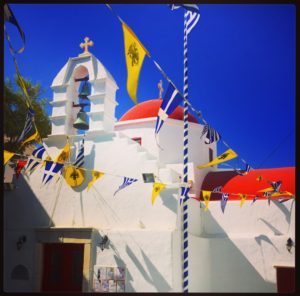
There are many beaches on the island, but the famous ones (where the celebrities hang out and the beach parties take place) are on the south-west coast. Having a car and a more-than-average budget to spend will both come handy. Psarou, Paraga, Paradise and Super Paradise are the best-known and most expensive ones and they are all organized. Sunbeds may cost a small fortune, but the combination of crystalline waters, signature summer cocktails and luxurious atmosphere is compensation. Psarou is home to the renowned restaurant Nammos, whereas Super Paradise is home to JackieO’ Beach Club and Restaurant. Enjoy the dazzling turquoise waters, then join the party and dance till late.
To further enhance your travel experience, save a day for a guided tour to the nearby island of Delos. Or, make Mykonos part of an island-hopping itinerary. Last but not least, Mykonos is one of the few islands where you can fly from abroad.
For more tips, check out my post ‘Mykonos: Top 7 tips by an (almost) local’.
Naxos
Inhabitants: 18,904
#Naxos: 576,168 posts
Naxos is the largest of the Cyclades. As such, it has many beaches and more than 30 – coastal and inland – villages worth exploring. It is also well-connected to the nearby islands; unless you have time constraints, you can combine a holiday in Naxos with island-hopping to the neighboring Mykonos (north), Paros (west), Ios (southwest), or to the Lesser Cyclades: Iraklia (south), Schinoussa (south), Koufonisia (south) or Donoussa (west). Naxos is one of the few islands with an airport.
Check out more tips for Naxos here.
Paros
Inhabitants: 13,715
#Paros: 715,247 posts
Paros is a very well-known island among Greeks, but somehow has managed to escape international attention. In the port town of Parikia, on the north-west side of the island, there’s the Byzantine church Panagia Ekatontapiliani (Virgin Mary with a hundred doors). Then, there’s the Insta-worthy harbor of Naoussa, on the north side of the island. An archetypal Cycladic town, picture-perfect Naoussa is lively and charming. Against a backdrop of white-washed cubic houses, labyrinthine cobblestone cat-laden alleyways and blushing bougainvilleas, the fortunate visitor will savor Cycladic cuisine at its best, followed by late-night cocktails by the sea. Centrally located in the archipelago, with Antiparos to the west and Naxos to the east, Paros is perfect for island-hopping. It is also is one of the few islands with an airport.
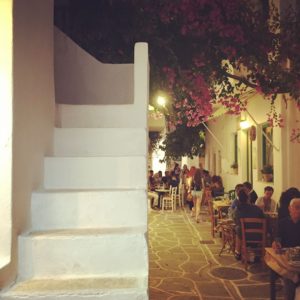
Santorini
Inhabitants: 15,550
#Santorini: 6,122,817 posts
Probably the most iconic Greek island, Santorini (or Thira, as it is also known as) is the southernmost island of the Cyclades. One of the most famous as well as the most visited Greek islands, it can become quite hectic in the summer.
Instagram-worthy Oia is definitely worth a visit. Afterwards, however, get off the beaten track and go to the inland village of Pyrgos Kallistis (or simply Pyrgos), built amphitheatrically at the highest point of the island. You know what comes next: panoramic views of the whole island (not just the caldera) make this the perfect place to watch the sunset that Santorini is worldwide famous for. Stroll through the narrow, labyrinthine streets, and then experience the Greek hospitality and local cuisine at Penelope’s Ouzeri, a small traditional eatery, or at Brusco ‘wine. coffee. deli’.
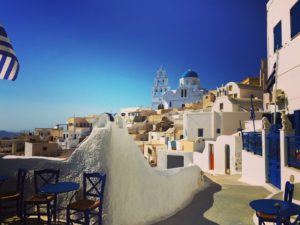
Santorini is famous for delicious appetizers not normally found elsewhere in Greece. Try the ntomatokeftedes (tomato balls/fritters), the locally-produced cheese (hlorotyri), fava (yellow split-peas) and white eggplants. Locally-produced Santorini and Vinsanto wines are both made from the indigenous grape Assyrtiko; the latter is a sweet dessert wine.
Santorini can easily be combined with island-hopping to the nearby islands of Amorgos, Anafi and Folegandros. It is also one of the few islands where you can fly from abroad.
For more tips, check out my post ‘Santorini: Top 9 tips by an (almost) local‘.
Schinoussa
Inhabitants: 256
#Schinoussa: 7,374 posts
Located south of Naxos, with Iraklia on the west and Koufonisia on the east, Schinoussa (also spelled Schoinoussa) is one of the tiniest inhabited islands in the archipelagos. Of the Lesser Cyclades, it is the second most populated, after Ano Koufonisi. Nowadays home to about 250 people, Schinoussa has actually been inhabited since antiquity.
Serifos
Inhabitants: 1,420
#Serifos: 93,284 posts
I visited Serifos two summers ago. Preparing for my trip, I had read that this relatively small island has over 70 beaches. Now, it’d be a blatant lie if I said I’d been to all of them. Making friends with the locals, however, saved me time and helped me decide which ones to visit. One of the most famous and my personal favorite is Agios Sostis. For this east-facing beach takes its name from the chapel overlooking the small bay. The beach is neither organized nor has any facilities (whether a beach bar, tavern or even a canteen); so make sure you bring a beach towel, a book, food, and water if you are to spend the day there.
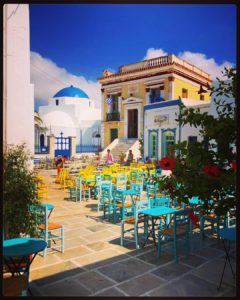
Built on the slopes of a hill, Hora is a whitewashed village overlooking the port of Livadi and all the while offering panoramic views of the Aegean Sea. This is where you should be starting and finishing your days on the island. In the main square, you’ll find the neo-classical town hall and the Greek Orthodox church of Agios Athanasios, as well as colorful chairs and tables from the cozy cafes around the square. In the evening, pick a bar, join the lively crowd and enjoy a cocktail (or two) under the moonlight sky.
For more tips, check out my post ‘Serifos: the Greek island where time stands still‘ (this is my 3rd most popular post of all times).
Sifnos
Inhabitants: 2,625
#Sifnos: 169,382 posts
Nikolaos Tselementes was a Greek chef and cookery writer born on the island of Sifnos in the late 19th century. 130 years later, this small Cycladic island is considered the capital of Greek gastronomy.
Fish and seafood play a protagonist role in the Cycladic cuisine; however, Sifnos is famous for a dish called ‘mastelo’: goat or lamb marinated in red wine and oven-cooked in ceramic pots made on the island. Other local specialties include ‘revithada’ (a chickpea soup or stew), ‘revithokeftedes’ (chickpeas croquettes or fritters) and ‘kaparosalata’ (caper salad). Don’t forget to try the island’s cheese ‘manoura’, made from sheep and goat milk. For dessert, try ‘melopita’ (honey pie) and ‘amygdalota’ (marzipan-based sweets).
If you visit Sifnos in early September, you’ll come across the Cycladic Gastronomy Festival ‘Nikolaos Tselementes’, a unique opportunity to savor not only the local cuisine, but also dishes from other Greek islands.
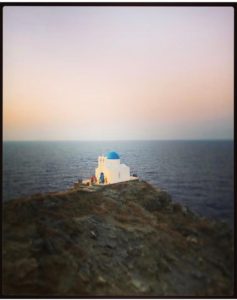
Delicious food aside, Sifnos is worth visiting for her beautiful landscapes too. Wander around Kastro with the narrow alleyways and the whitewashed houses (most of them date back to the Venetian times), but make sure you find your way to the Church of the Seven Martyrs, probably the most Instagrammable spot on the island. Walk around the small church for breath-taking views of the Aegean, before heading back to Kastro to enjoy a meal at ‘Nea Lontzia’ or a mojito at ‘Cavo Sunriso’, an island institution. Then continue to ‘Dolci’ for a late-night cocktail at the bougainvillea-shaded terrace.
For more tips, check out my post ‘Sifnos: the island of Greek gastronomy‘ (this is my most popular post of all times).
Sikinos
Inhabitants: 273
#Sikinos: 15,563 posts
Nestled between Folegandros on the west, and Ios on the east, lies Sikinos. Despite its close proximity to party island Ios, Sikinos has remained a quiet and off-the-beaten-track island.
Check out more tips for Sikinos here.
Syros
Inhabitants: 21,507
#Syros: 221,893 posts
Despite being rather small in size, Syros (not to be confused with Skyros) is the most populated of the Cyclades. This is not surprising considering that Ermoupoli, the island’s capital, is also the administrative capital of the Cyclades. With its neo-classical buildings, this beautiful port town is reminiscent of the Dodecanese islands. Syros is also home to a significant number of Roman Catholic churches, as well as Greek Orthodox ones. Amongst those, there’s the Saint George’s Cathedral, dating back to 1200 AD, and the Church of Kimisi tis Theotokou, which houses an icon by the Cretan-born, world-renowned painter El Greco.
Thanks to its central location in the Cyclades archipelago, Syros can easily be part of an island-hopping itinerary. You can also get there by plane (from Athens).
Check out more tips for Syros here.
Tinos
Inhabitants: 8,636
#Tinos: 198,572 posts
Tinos (not to be confused with Tilos in the Dodecanese) is another island where both Greek Orthodox and Roman Catholic populations co-exist. Despite its vicinity to the hedonistic Mykonos, this island is a popular destination (among Greeks) for a very different reason: it is home to the Church of Panagia Evangelistria (Church of the Holy Virgin), which houses a reputedly miraculous icon of Panagia (Virgin Mary). For this reason, Tinos has become Greece’s main pilgrimage site.
But, of course, you don’t have to be religious to visit Tinos. The island, often referred to as ‘the Aegean Muse’, has a lot more to offer to the fortunate visitor. For the ultimate holiday experience, you can combine Tinos with the neighboring Mykonos.
Check out more tips for Tinos here.
Further island-hopping
Although the Cyclades are the most archetypal of the Greek islands, there are many more worth visiting. Greece has a total of about 6,000 islands of which 227 are inhabited. When people ask me which one to visit (a frequently asked but rather difficult question to answer), Skyros (not to be confused with Syros) is always the first to come to mind.
Located north of the Cyclades and east of Evia (or Euboea), Skyros is a great place to unwind, relax and enjoy some peace and quiet. One may argue that most Greek islands are such places. True. However, there is a very good reason why Skyros tops that list. The island is home to Skyros Center, Europe’s first course-based holiday center, which is unsurprisingly included in the Wellness Escapes. Located in Atsitsa in the north-western part of the island, it is one of the 4 retreats in Greece featured in the Lonely Planet edition. Now in its 41st year, Skyros Center offers yoga, health and wellbeing retreats, but also art and writing courses.
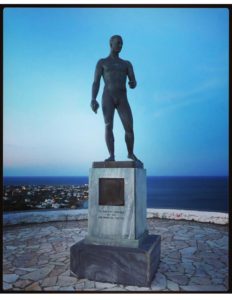
Skyros is also a magnet for intellectuals, hippies, and hipsters for decades. The reason? Here lies the olive grove where the English poet Rupert Brooke was buried during the First World War, when the Tris Boukes bay was used as an anchorage for hospital ships treating the wounded from Gallipoli. A century later, the ‘Statue of an Ideal Poet’, erected in memory of the famous Englishman, stands tall high above the Aegean in a small square that bears his name. Also known as the ‘Square of Eternal Poetry’, it offers a panoramic view of the popular beaches of Magazia, Molos, and Gyrismata.
For more tips, check out my post ‘Skyros: the island of wellness & wellbeing‘.
Further reading
To better prepare for your island-hopping holiday, I would recommend the Lonely Planet Greek Islands Travel Guide.
Have a great (island-hopping or not) journey!
Alex
(the soon-to-be-Traveling-again-Psychiatrist)